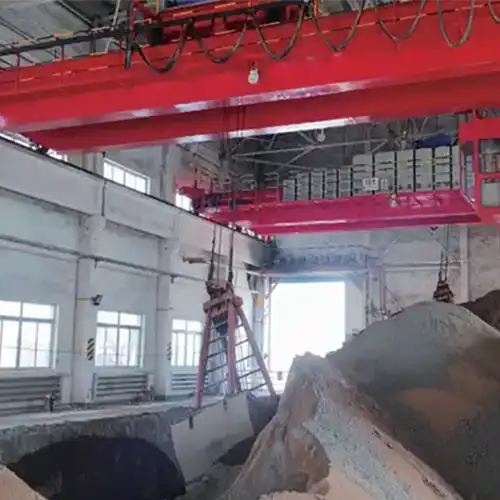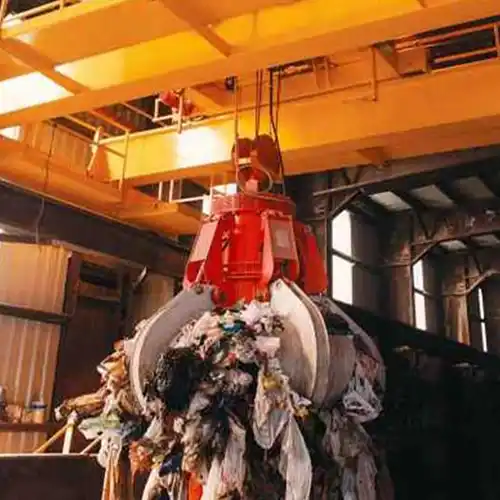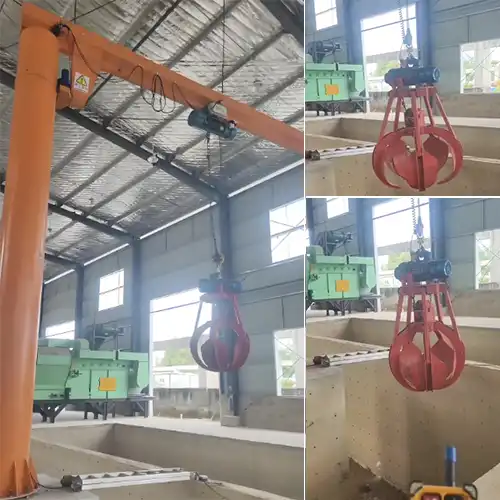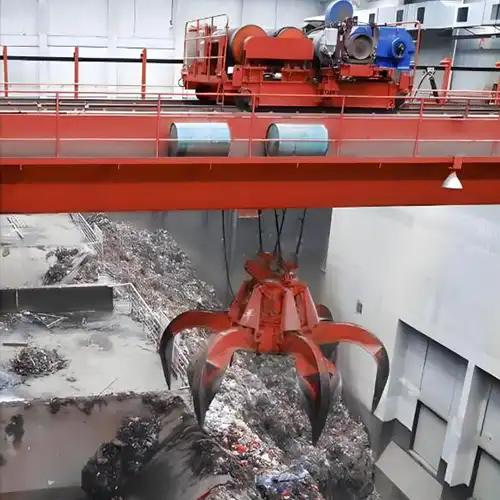Intelligent Grab Bucket Overhead Cranes in Coal Mining
Automation with intelligent cranes enhances efficiency, safety, and cost-effectiveness in coal handling, transforming mining operations for the better.
Category: Grab Crane
Your Trusted Overhead Grab Bucket Crane Manufacturer & Supplier
Intelligent Grab Bucket Overhead Cranes for Coal Mining Handling
Automation with intelligent cranes enhances efficiency, safety, and cost-effectiveness in coal handling, transforming mining operations for the better.
Intelligent Grab Bucket Overhead Cranes
Revolutionizing Coal Handling in Mining Operations
Overview of Coal Handling in Mining Operations
Coal mining is a vital industry for energy production. Efficient material handling is crucial to keep operations running smoothly. It involves moving, processing, and storing raw coal and byproducts in a safe and productive manner. But this process can be challenging.
In many coal mines, traditional coal handling methods are still in use. This often leads to inefficiency, slow processes, and high costs. Workers rely on manual methods, like using grab buckets, which can lead to human error. Manual labor is also slow, requiring a lot of effort to move heavy loads.
Challenges faced:
- High energy consumption due to inefficient material handling.
- Risk of injury from heavy lifting and poor working conditions.
- Slow processes that reduce overall production speed.

The Shift Towards Automation
The need for better solutions is clear. Heavy industries, like coal mining, are shifting towards automation to address these problems. Automation promises to make operations safer, more efficient, and cost-effective.
One of the most promising developments in automation is the intelligent grab bucket overhead crane. These cranes are transforming how coal is handled in mining operations. They can automatically load, transport, and stack materials with minimal human intervention. The result? A significant improvement in operational efficiency. c
Automation advantages:
- Reduced labor costs.
- Fewer errors and higher accuracy.
- Safer working conditions for employees.
As a crane manufacturer of industrial overhead cranes, we can provide a wide range of industrial cranes including industrial overhead crane, and industrial gantry crane, and jib crane for material handing in coal. If you have any need, please feel free to contact us. In the following, the intelligent grab bucket overhead crane is presented for your reference.
Industry Challenges in Traditional Coal Handling
Inefficiencies in Manual Operation
In traditional coal handling, operations are heavily reliant on human experience. Workers manually control grab buckets to move coal, often without automation. This leads to slow processes and inconsistent results.
- Grab bucket swinging is a common issue. When the bucket swings too much, it wastes energy and slows down the entire process.
- Human error also plays a role. Workers may miscalculate loads or misdirect materials, causing delays.
- This results in energy loss, as inefficient movements require more power to complete tasks. Productivity drops when things aren't running smoothly.
Harsh Work Environments
Coal handling environments are tough. Workers face challenging conditions that can impact their health and safety.
- Noise levels are often extremely high due to the heavy equipment used, creating an unsafe working environment.
- Dust is another issue. Coal dust can cause respiratory problems, making it difficult for workers to stay healthy.
- Many facilities lack proper ventilation, meaning workers are forced to endure poor air quality and excessive heat.
These harsh conditions make it harder for workers to perform efficiently and safely. The longer workers are exposed to these conditions, the higher the risk of injury or illness.
Limited Productivity and Safety Concerns
Traditional methods of coal handling also come with significant productivity issues.
- Low labor efficiency is a common problem in manual coal handling. Workers spend too much time on repetitive tasks, and it takes longer to move the same amount of material.
- Operational downtime occurs due to equipment failure or delays in manual handling. Any mistake in the process can halt production for hours, impacting overall output.
- Safety risks are heightened when workers are required to handle dangerous materials and equipment. The risk of injury increases when human error is involved.
These challenges highlight the need for more efficient and safer systems in coal handling. Without addressing these issues, mining operations may continue to struggle with high costs and low productivity.
The Role of Intelligent Grab Bucket Overhead Cranes
Key Features of Intelligent Cranes
- SCADA Integration: Full Automation and Centralized Control
Intelligent grab bucket cranes are fully automated, thanks to SCADA (Supervisory Control and Data Acquisition) systems. These systems allow for centralized control of all operations, meaning one operator can monitor and manage multiple cranes and processes simultaneously. Automation eliminates human error and reduces the need for manual intervention, making operations faster and more reliable. - AI Vision Technology: Optimized Operation Perspectives, Real-Time Monitoring
These cranes are equipped with AI vision technology that provides operators with the best possible view of the operation in real time. The system optimizes crane movement, offering accurate perspectives on how materials are being handled. Real-time monitoring allows for instant adjustments to keep everything running smoothly. This ensures that materials are moved efficiently without wasting time or energy. - Advanced Load Stability Control: Anti-Swing Features, Precise Handling
Load stability is crucial for safe and efficient material handling. Intelligent cranes are designed with anti-swing technology, which minimizes the swinging motion of the grab bucket. This reduces energy loss and improves handling precision. The crane's precise handling ensures materials are placed accurately, improving the overall stability of the process. - Multi-Device Coordination: Integrated Operation with Ball Mills, Feeders, and Pumps
One of the standout features of intelligent cranes is their ability to coordinate with other equipment. Cranes can work seamlessly with ball mills, feeders, and pumps, allowing them to adjust their movements based on real-time data. This integrated operation ensures that all equipment functions as a single system, reducing downtime and increasing efficiency in the coal handling process. - Smart Material Stacking Algorithms: Ensuring Stable and Organized Material Piles
Efficient material stacking is key in coal handling. Intelligent cranes use advanced algorithms to create stable, organized piles of coal or other materials. These smart stacking algorithms help prevent waste, ensure easier future access to materials, and optimize storage space. The system can adjust to different material types and amounts, maintaining stability even in complex stacking environments.
Real-Time Decision Making
- AI-Driven Algorithms for Automatic Adjustments
One of the key advantages of intelligent cranes is their ability to make real-time decisions based on AI-driven algorithms. These algorithms analyze data from the crane, surrounding equipment, and material conditions, making automatic adjustments to optimize the handling process. For example, if the crane detects an overload, it can automatically adjust its speed or operation to prevent damage. - Intelligent Tracking of Crane Performance and Material Movement
These cranes continuously track their performance and monitor the movement of materials. The system collects data on each lift, placement, and movement, providing operators with valuable insights. This allows for ongoing optimization of the crane's operation, ensuring materials are handled in the most efficient way possible. Operators can also track material flow and anticipate potential issues before they arise, making the entire operation more proactive.
These intelligent features help coal mining operations run more smoothly, saving time, energy, and resources.
Applications in Coal Mining & Preparation Plants
Raw Material Handling
Efficient transportation of coal, magnetite powder, and other materials is essential in mining operations. Intelligent overhead cranes streamline this process by automatically lifting and moving heavy loads with precision. These cranes work seamlessly alongside automated feeders and ball mills, ensuring the smooth transfer of materials through the entire system. The integration of these cranes reduces delays, minimizes human error, and improves overall productivity by eliminating bottlenecks.
Key Benefits:
- Faster transportation of materials to processing units.
- Reduced manual labor and human error.
- Increased throughput and continuous operation.
Feeding Processes
In coal preparation, the feeding process is critical for consistent and accurate material delivery to ball mills and other equipment. Intelligent cranes are automated to coordinate with downstream equipment, ensuring that the right amount of material is fed at the right time. This coordination leads to enhanced feeding speed and precision in material handling.
Key Benefits:
- Higher precision in material feeding, reducing waste.
- Continuous, uninterrupted flow of materials to processing units.
- Reduced risk of overfeeding or underfeeding, ensuring optimal processing conditions.
Material Stacking & Storage
Efficient material stacking is essential to reduce waste and optimize storage. Intelligent cranes use smart algorithms to create stable and organized piles of coal and other materials. These algorithms ensure that the material is stacked in a way that maximizes space and prevents instability, which can lead to accidents or damage.
Key Benefits:
- Improved material organization and accessibility.
- Stable piles that prevent accidents and material loss.
- Optimized use of storage space, reducing the need for excess storage.
Waste Handling & Transport
Coal mining operations often produce large amounts of waste material, including coal slurry and other byproducts. Intelligent overhead cranes are designed to handle this waste more efficiently. Automation reduces the need for manual handling, cutting down on the time and energy required to move waste materials.
Key Benefits:
- Faster, more efficient transport of coal slurry and waste.
- Reduced handling time and lower energy consumption.
- Minimized labor costs and reduced exposure to harmful environments for workers.
By integrating intelligent cranes into coal mining and preparation plants, these operations can achieve significant improvements in efficiency, safety, and cost-effectiveness. Automation leads to a smoother workflow, reduces downtime, and boosts overall productivity across the entire operation.
Key Benefits of Intelligent Grab Bucket Cranes in Coal Handling
Increased Operational Efficiency
Intelligent grab bucket cranes significantly improve the efficiency of coal handling operations. By automating processes, these cranes reduce cycle times, meaning less time is spent moving materials. This results in enhanced throughput, allowing more coal to be handled in less time.
- Streamlined Handling: With precise control over load movements, these cranes ensure that materials are lifted and transported smoothly, minimizing delays caused by inefficient handling.
- Optimized Load Distribution: The crane's advanced technology ensures that loads are distributed evenly, preventing overloading and reducing wear and tear on equipment. This leads to smoother operations and fewer interruptions.
Cost Reduction
Switching to intelligent cranes leads to cost savings in multiple areas.
- Accurate Tracking of Coal Medium Consumption: Intelligent cranes continuously monitor and track the consumption of coal mediums like magnetite powder. This helps operators optimize usage, reducing waste and making cost predictions more accurate.
- Lower Energy Costs: The precision and efficiency of automated cranes reduce energy consumption. Fewer miscalculations and delays mean less energy is wasted on unnecessary movements or downtime.
These improvements lead to lower operational costs and more predictable budget management for mining operations.

Improved Worker Safety & Health
Worker safety and health are enhanced by the automation provided by intelligent cranes.
- Remote Operation Capabilities: These cranes can be operated remotely, reducing the need for workers to be directly exposed to dangerous environments. By operating from a safer distance, the risk of accidents is minimized.
- Healthier Work Conditions: Intelligent cranes help control environmental factors such as noise and ventilation. They are designed to reduce noise pollution and improve air quality, ensuring a safer and more comfortable working environment for employees.
With safer conditions, workers are at a lower risk of injury or long-term health issues, promoting overall well-being.
Labor Optimization
By automating manual tasks, intelligent cranes optimize the use of labor.
- Shifting Workforce to Skilled Roles: As manual labor tasks are taken over by automated cranes, workers can be reassigned to more skilled roles like equipment monitoring, inspection, or quality control. This enhances the overall skill level of the workforce.
- Enhanced Worker Productivity and Morale: Automation reduces the physical strain on workers and frees them from repetitive, tedious tasks. This results in increased worker morale and productivity, as employees are more likely to be engaged in meaningful work.
Labor optimization not only improves efficiency but also helps retain a happier and more skilled workforce.
By adopting intelligent grab bucket cranes, coal handling operations see a boost in productivity, cost-effectiveness, and worker satisfaction. These benefits are key to long-term success in a highly competitive industry.
Impact: Case Study of Coal Preparation Plant Automation
Before and After Implementation
Before automation, coal handling at the preparation plant relied heavily on manual processes. Workers used grab buckets manually to move coal, magnetite powder, and waste materials. This led to slow operations, inconsistent load handling, and a higher risk of errors.
Manual Handling Challenges:
- High labor costs due to the need for numerous workers.
- Inefficient use of energy and resources, leading to unnecessary costs.
- Increased risk of accidents and injuries due to the manual nature of the work.
After the implementation of intelligent grab bucket cranes, the plant saw a significant shift. Automated cranes took over most of the material handling tasks, operating with more precision, efficiency, and safety. This shift resulted in a streamlined, automated system that reduced human error and increased productivity.
Key Operational Improvements:
- Reduced cycle times and smoother material handling.
- Fewer operational interruptions caused by human error.
- Improved load distribution, ensuring better use of equipment and reducing wear and tear.
Efficiency Gains
The transition to automated crane systems brought notable efficiency improvements:
- Energy Savings: Intelligent cranes operate with minimal energy loss. Thanks to features like load stability control and anti-swing technology, the cranes reduce unnecessary movements, which in turn reduces overall energy consumption.
- Reduced Handling Time: The automated system operates at a faster pace compared to manual handling. By eliminating human delays and optimizing crane movements, the handling time for coal and materials was reduced significantly, leading to higher throughput.
- Increased Throughput: With reduced cycle times and faster material handling, the plant was able to process more coal in less time. This increase in throughput not only boosted production but also made better use of the plant's resources and equipment.
Workforce Transformation
The shift from manual labor to automation had a significant impact on the workforce:
- Labor Transition: Many workers were reassigned to more value-added tasks such as equipment monitoring, quality control, and system maintenance. This allowed the workforce to apply their expertise in a more strategic and skilled manner, rather than performing physically demanding and repetitive manual labor.
- Enhanced Worker Satisfaction: With reduced physical strain and more engaging tasks, worker morale improved. Employees were more motivated as they were able to focus on tasks that required higher skill levels, like troubleshooting equipment or optimizing processes.
Customer Feedback
- Operators' Insight: According to plant operators, the introduction of intelligent cranes made their work much easier and safer. They no longer had to deal with the physical challenges and safety risks associated with manual handling. One operator mentioned that "the automation system reduced the stress of working in a noisy, dusty environment and increased my confidence in the work being done."
- Management's Perspective: The management team praised the crane automation for its cost-saving benefits and increased production capacity. They were particularly impressed by the reduced downtime and the consistent quality of the material handling. A plant manager noted, "The move to automation has allowed us to scale operations smoothly, without the typical delays and issues associated with manual work."
This case study highlights the significant impact that automation, specifically intelligent grab bucket cranes, can have on coal preparation plants. The transition led to improvements in energy efficiency, throughput, and safety, while also optimizing the workforce and enhancing worker satisfaction.
Intelligent Overhead Cranes in Coal Mining
Advancements in AI and Automation
As technology continues to evolve, AI and automation will play an even more significant role in enhancing coal mining operations. The future of intelligent overhead cranes is closely linked to cutting-edge advancements in these fields.
- Future AI Applications for Predictive Maintenance: One of the most promising developments is the use of predictive maintenance powered by AI. Using real-time data from cranes and other equipment, AI systems will predict when maintenance is needed before any issues arise. This allows for proactive repairs and reduces the likelihood of unexpected breakdowns, minimizing downtime and extending the lifespan of equipment.
- Crane Optimization: In addition to predictive maintenance, AI will help optimize crane operations even further. AI algorithms will continuously learn from data, refining crane movements for maximum efficiency. This can lead to smarter load handling, improved material flow, and better overall operational efficiency.
Integration with IoT
The integration of intelligent cranes with the Internet of Things (IoT) will unlock new levels of performance and data-sharing capabilities in coal mining operations.
- Real-Time Data Sharing: IoT sensors installed on cranes, conveyors, and other equipment will allow for real-time data collection and sharing. This will give operators continuous insights into the performance of the entire system. For example, operators will be able to monitor crane health, material flow, and operational efficiency from a single dashboard.
- Continuous Performance Improvement: With real-time feedback, crane systems can be automatically adjusted to optimize their performance. The system can suggest or even implement changes on the fly, ensuring that the operation is always running at peak efficiency. This kind of connected, data-driven decision-making will lead to smoother operations and better resource allocation.
Sustainability Focus
Sustainability is becoming a central focus in the mining industry, and intelligent overhead cranes can play a key role in this shift.
- Energy-Efficient Systems: The future of intelligent cranes includes systems that are not only more efficient in their operations but also energy-conscious. These cranes will be designed to use less power while maintaining high performance. Features like energy recovery during braking and more efficient motors will help reduce the energy footprint of crane operations.
- Eco-Friendly Automation Solutions: As the industry moves toward more eco-friendly automation, future cranes will be designed with sustainability in mind. This includes using sustainable materials, minimizing waste, and ensuring that the automation systems themselves contribute to a greener operation. Additionally, integrating these cranes with renewable energy sources such as solar or wind could further reduce the environmental impact.
- Impact on Reducing the Carbon Footprint: Automation systems, combined with energy-efficient technologies, will contribute significantly to reducing the carbon footprint of coal mining operations. By cutting down on energy consumption and optimizing resource usage, intelligent overhead cranes will help mining companies meet their sustainability goals and adhere to increasingly strict environmental regulations.
The future of intelligent overhead cranes in coal mining looks promising. With advancements in AI, IoT integration, and sustainability efforts, these cranes will not only improve operational efficiency but also contribute to a safer, more eco-friendly, and cost-effective mining industry. The combination of automation and cutting-edge technologies will ensure that the industry is better equipped to meet the challenges of tomorrow.
Conclusion
Summary of Key Benefits
Intelligent grab bucket cranes have proven to be a game-changer for coal handling operations. These advanced systems offer a host of benefits:
- Enhanced Efficiency: By automating material handling, these cranes reduce cycle times, streamline operations, and increase throughput, all while minimizing delays and human error.
- Improved Safety: Automation reduces worker exposure to dangerous environments, while advanced features like load stability control ensure smooth and safe crane operations.
- Cost-Effectiveness: With energy-efficient systems, reduced downtime, and optimized labor usage, intelligent cranes help lower operational costs and improve overall profitability.
Incorporating these intelligent systems not only boosts productivity but also ensures a safer, more sustainable approach to coal mining operations.
Long-Term Industry Impact
The integration of automation in coal mining is setting a new standard for the industry. As intelligent grab bucket cranes and other automation technologies continue to evolve, the coal mining sector will experience significant improvements in:
- Operational Efficiency: Reduced energy consumption, faster handling times, and streamlined processes will define the next generation of mining operations.
- Worker Transformation: Automation allows workers to transition into more skilled roles, focusing on value-added tasks such as equipment monitoring, predictive maintenance, and quality control.
- Environmental Impact: By reducing energy usage and supporting sustainability efforts, automation helps coal mining operations lower their carbon footprint and comply with stricter environmental regulations.
Automation is shaping the future of coal mining, pushing the industry toward higher efficiency, safety, and sustainability standards.
Coal preparation plants looking to enhance their operational performance should strongly consider automation as a key solution for long-term improvement. By adopting intelligent grab bucket cranes, plants can:
- Improve productivity and safety.
- Cut operational costs and energy consumption.
- Stay ahead of industry trends and future-proof their operations.
Now is the time for coal preparation plants to embrace automation, ensuring they remain competitive, efficient, and sustainable in the years to come.If you have any need of intelligent grab bucket overhead crane, please feel free to contact us to get your customized design.
Related Products
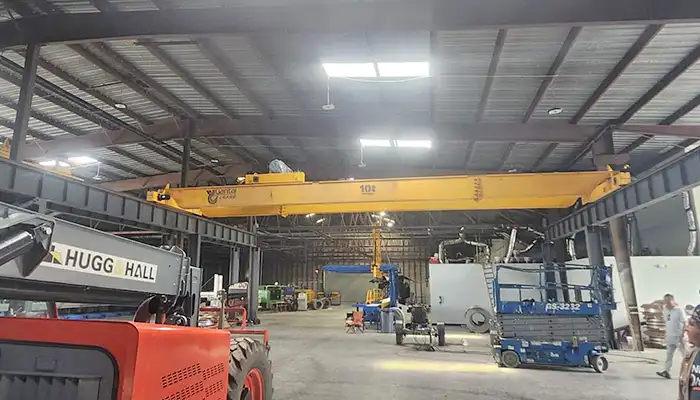
Affordable 10 ton double girder overhead crane with CD/MD hoist trolley, built for U.S. standards, ideal for construction and industrial lifting
Free consultation to Confirm Parameters & Specifications and Get
Latest Crane Price & Crane Rate.
- Types of overhead cranes : _______?
- Optional: Overhead travelling crane, goliath gantry crane,Slewing jib crane, Single girder or double girder crane,small portable crane or kbk crane, etc.
- Capacity of overhead crane: _______?
- Optional: 0.25ton, 0.5 ton, 1 ton, 2 ton, 3ton, 5 ton, 10 ton,15ton, 20ton, 25 ton, 30ton,35ton, up to 550ton, etc.
- Crane span & lifting height : _______?
- Crane travelling length : _____?
- Control of overhead crane:_______?
- Optional: pendant/ remote/cabin control
- Voltage supply of overhead crane:_____?
- Eg,: 380V50/60HZ,3Phase or others,etc.
- Application/usage of crane:_______?
- Eg,: Steel mill, ,injection mold, cement,stone, concrete,granite, general manufacturing, etc.
Just leave a message via the contact form and our hoist and crane engineer will contact you with in 24working hours.
Get In Touch
